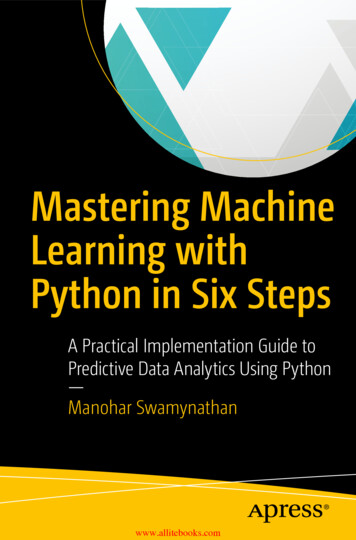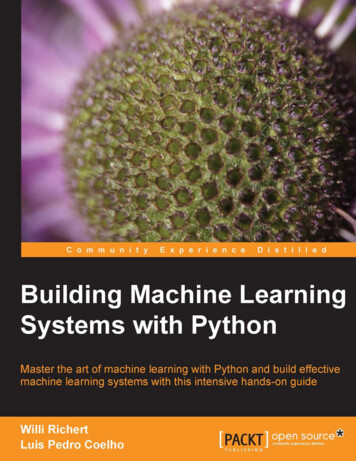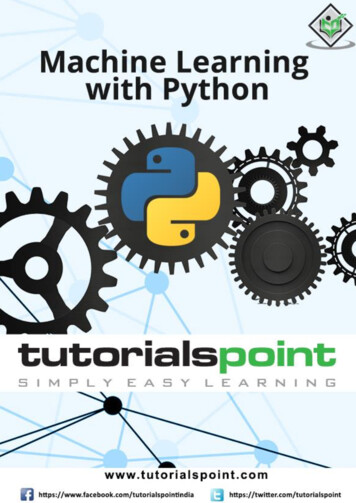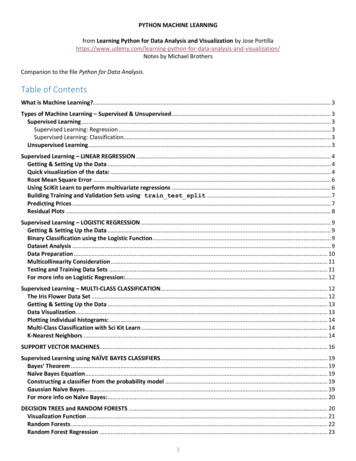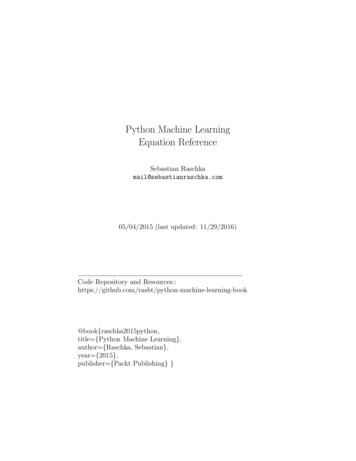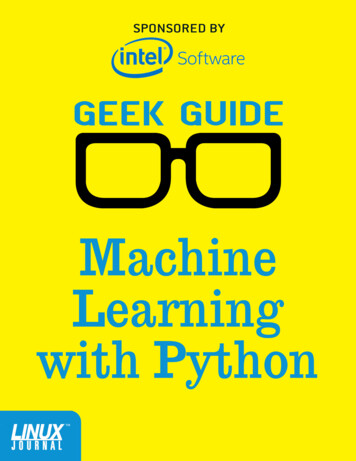
Transcription
GEEK GUIDE Machine Learning with PythonTable of ContentsAbout the Sponsor 4What Is Machine Learning? 6Supervised vs. Unsupervised Learning 11Models: the Core of Machine Learning 13Python and scikit-learn 15An Example of Machine Learning 17Validating 23Comparing Models 25Conclusion 26Resources 27Reuven M. Lerner offers training in Python, Git and PostgreSQL to companies around the world.He blogs at blog.lerner.co.il, tweets at @reuvenmlerner and curates DailyTechVideo.com.Reuven lives in Modi’in, Israel, with his wife and three children.2
GEEK GUIDE Machine Learning with PythonGEEK GUIDES:Mission-critical information for the most technical people on the planet.Copyright Statement 2016 Linux Journal. All rights reserved.This site/publication contains materials that have been created, developedor commissioned by, and published with the permission of, Linux Journal(the “Materials”), and this site and any such Materials are protected byinternational copyright and trademark laws.THE MATERIALS ARE PROVIDED “AS IS” WITHOUT WARRANTY OF ANY KIND,EITHER EXPRESS OR IMPLIED, INCLUDING BUT NOT LIMITED TO, THE IMPLIEDWARRANTIES OF MERCHANTABILITY, FITNESS FOR A PARTICULAR PURPOSE,TITLE AND NON-INFRINGEMENT. The Materials are subject to change without noticeand do not represent a commitment on the part of Linux Journal or its Web sitesponsors. In no event shall Linux Journal or its sponsors be held liable for technicalor editorial errors or omissions contained in the Materials, including without limitation,for any direct, indirect, incidental, special, exemplary or consequential damageswhatsoever resulting from the use of any information contained in the Materials.No part of the Materials (including but not limited to the text, images, audioand/or video) may be copied, reproduced, republished, uploaded, posted,transmitted or distributed in any way, in whole or in part, except as permitted underSections 107 & 108 of the 1976 United States Copyright Act, without the expresswritten consent of the publisher. One copy may be downloaded for your personal,noncommercial use on a single computer. In connection with such use, you may notmodify or obscure any copyright or other proprietary notice.The Materials may contain trademarks, services marks and logos that are theproperty of third parties. You are not permitted to use these trademarks, servicesmarks or logos without prior written consent of such third parties.Linux Journal and the Linux Journal logo are registered in the US Patent &Trademark Office. All other product or service names are the property of theirrespective owners. If you have any questions about these terms, or if you wouldlike information about licensing materials from Linux Journal, please contact usvia e-mail at info@linuxjournal.com.3
GEEK GUIDE Machine Learning with PythonAbout the SponsorIntel Software and Services GroupThe Intel Software and Services Group (SSG) employsthousands of software-focused professionals, andmeasured by engineering staff size, SSG would be amongthe world’s top 10 software companies if it were anindependent organization.Recognizing that software is tightly coupled with, anda vital element of, all Intel platforms and processors, SSGis a worldwide provider of software products and services,design resources, technical expertise and consulting. SSGprimarily works with software companies such as Adobe,Microsoft and Oracle, and directly with CIOs of majorcorporations such as DreamWorks and Reuters Financial,as well as with individual software developers.Through SSG’s comprehensive enabling efforts, thesoftware community can take maximum advantage ofIntel processor technologies across the computingspectrum from the Intel Atom TM processor in small formfactor mobile computing to Intel Core TM processor andIntel Xeon processor families in computers, serversand entire IT infrastructures. SSG works with developersto enhance innovation and gain the best possibleperformance, uptime and efficiency. In addition, SSG isan integral part of the microprocessor design process,ensuring software requirements are comprehended in thedevelopment of future architectures and silicon designs.4
GEEK GUIDE Machine Learning with PythonMachineLearningwith PythonREUVEN M. LERNERI first heard the term “machine learning” a few yearsago, and to be honest, I basically ignored it that time. Iknew that it was a powerful technique, and I knew thatit was in vogue, but I didn’t know what it really was—what problems it was designed to solve, how it solvedthem and how it related to the other sorts of issues I wasworking on in my professional (consulting) life and in mygraduate-school research.But in the past few years, machine learning has becomea topic that most will avoid at their professional peril.Despite the scary-sounding name, the ideas behind machinelearning aren’t that difficult to understand. Moreover,a great deal of open-source software makes it possiblefor anyone to use machine learning in their own work or5
GEEK GUIDE Machine Learning with PythonHuman minds basically are pattern-matchingmachines and excel at finding commonalitiesamong different types of inputs; getting acomputer to perform such categorizationtasks is more than just an impressive trick.research. I don’t think it’s an overstatement to say thatmachine learning already is having a huge impact on thecomputer industry and on our day-to-day lives.In this ebook, I introduce the basic ideas behind machinelearning and show how you can use Python to applymachine learning ideas to a number of different problems.I hope by the time you finish reading this guide, you’ll notonly understand what machine learning aims to do, but alsohow to apply it to your own work and research.What Is Machine Learning?Before doing anything else, let’s define the terms:“machine learning” sounds somewhat ominous, leadingto a Matrix-like world in which the machines have takenover. But machine learning, at least as our current worldsees it, is a mechanism by which computers can putinputs into categories.Wait, that’s it? No, but that’s a very good starting pointfor thinking about machine learning.Human minds basically are pattern-matching machines6
GEEK GUIDE Machine Learning with Pythonand excel at finding commonalities among differenttypes of inputs; getting a computer to perform suchcategorization tasks is more than just an impressive trick.It means that computers can look through a large numberof inputs and try to categorize those inputs.And, of course, if there’s something that computers dobetter than people, it’s look through large quantities of data.A related use of machine learning is to predict outputsbased on inputs with some degree of certainty. So ifI present you with an input value—a child’s age, forexample—then you can predict that child’s height. Willyour prediction be exact? No, but that’s okay; machinelearning uses statistical reasoning. Thus, you’re lookingfor likely outcomes, not definite outcomes.Because this is something that statisticians have beendoing for years, there definitely are people who ask howmachine learning is different from just statistics. Onepossible answer is that regression, one of the cornerstones ofstatistics, is just one type of model used in machine learning.For example, let’s say you’re a credit-card company andyou’re trying to determine whether a purchase is legitimateor fraudulent. Too many false positives, and your customerswill be angry. Too many false negatives, and you’ll soonbe out of business. Machine learning makes it possible toanalyze someone’s purchase history and determine whethera purchase is likely to be good or bad.Another common and famous example is that ofidentifying e-mail spam. It used to be that spam wasnot only obnoxious, but also easy to identify. Today,spammers use a variety of techniques to make their e-mail7
GEEK GUIDE Machine Learning with Pythonlook legitimate. Machine learning allows a computer toaccumulate information over time, getting an increasinglyclear picture of what is considered a legitimate message.And of course, if you’ve bought anything on-line inthe last decade, you’ve likely been told that “people whobought this product also bought.”, followed by a longlist of things that, when you think about it, actually areof interest to you. This sort of categorization also can beattacked using machine learning. As more informationis fed into the system, it can make increasingly accuratepredictions of what someone is likely to want to buy (oralready has bought from another store).As you can see, the number and types of problems thatcan be solved using machine learning is large and varied.Consider going back to when Claude Shannon and othersfirst proposed that people could encode boolean logic inelectrical circuits. Would you have imagined that todaywe would be holding powerful computers (mobile phones)in our pockets, sharing videos and e-mail messageseffortlessly and globally? In the same way, we’re onlyat the start of a revolution in machine learning, and itremains to be seen just how far this will go.There are, of course, some ways machine learning hasbeen used with, well, interesting results. Those resultsdon’t mean the technology is necessarily wrong, butrather that statistical models provide likelihoods, notcertainties. Uncertainty, matched with a large population,can create some awkward situations.One famous, early example involved TiVo, a digital videorecorder that chose what to watch based on your viewing8
GEEK GUIDE Machine Learning with PythonMoreover, we’re seeing how our ownorganizations can use machine learning tosell more products, understand customerneeds and even improve medical outcomes.patterns. A Wall Street Journal article from 2002 was titled“My TiVo Thinks I’m Gay”, and described someone trying toconvince his TiVo that his choice in television programs wasother than what the box’s algorithms had determined.Another famous case involved Target, which sent “soyou’re expecting” coupons to a customer based on herpurchasing patterns, which told the machine learningalgorithms that she was pregnant and would appreciatereceiving such discounts. What Target’s computer didn’trealize was that the customer in question was a teenagegirl who hadn’t told her parents about the pregnancy. Theparents, first irate at Target for making such seemingly unfairinferences, later directed their anger at their daughter.The social, ethical and business ramifications of machinelearning have yet to be determined. And yet, we’restarting to see how large companies and organizations areusing machine learning to sell more, keep people healthyand make everyone more productive.Moreover, we’re seeing how our own organizations canuse machine learning to sell more products, understandcustomer needs and even improve medical outcomes.9
GEEK GUIDE Machine Learning with PythonMachine learning is a new application of statisticalmodeling. For many people, the term “statistical modeling”might not mean much, despite its demonstrated depth andpower through many decades. But modeling is an importantfield, allowing people to describe and understand theworld, or certain features of it. Statistical modeling lets youuse previously collected data to make reasonable inferencesand predictions about future data.For example, the United States is now in the middle of anelection season. Before every debate, primary and caucus,numerous polls make predictions about who will win—andfor the most part, they can predict things accurately. Butin some cases, the pollsters say they don’t have enoughinformation from previous years’ elections to make areasonable prediction. Or, they may make predictions despitea lack of earlier data and end up with egg on their faces.Because machine learning is based on statisticalmodeling, it makes certain assumptions. First and foremost,it tries to find correlations among data, but doesn’t claim tofind causality. This is a well known statement, and one thatevery elementary statistics class attempts to teach—and yet,human instincts drive us toward seeing causality even whenthat’s far from demonstrated.Machine learning also works, as I wrote earlier, only whenthere is some data with which to consider. Is someone alikely terrorist risk? Is this envelope meant to be deliveredto Main Street or to Maine? Are you really a good potentialcustomer for a new romance novel? All of those questionscan be solved, to some degree, with machine learning—assuming that the system has sufficient inputs. Amazon’s10
GEEK GUIDE Machine Learning with Pythonfirst customer wasn’t recommended any books, becausethat functionality didn’t exist. But even if the software hadexisted, it wouldn’t have been possible to get a reasonablerecommendation, because there weren’t yet any purchases.And of course, machine learning is only as good as theinput data. If your input data has a limited number of factors,or those factors aren’t enough to distinguish betweenelements of your data set, machine learning won’t be ableto do much for you. If your data set contains a great deal ofnoise, or outliers, then machine learning might not help.Supervised vs. Unsupervised LearningI’ve already described machine learning as a way of having acomputer put input data into categories. At the same time,I indicated that the “learning” part of machine learningcomes from the fact that the system’s model improves withtime, as it gets more (good) input data. However, there’sstill the question of how the computer is supposed to knowhow to categorize things.For example, let’s take a set of people. Say you have abunch of information about them, including gender, age,height, weight and nationality. In most cases, you won’t wantto use all of those factors. The type of categories into whichyou want to sort data will drive the factors you use. Thus, ifyou want to categorize by driving ability, you’ll use differentfactors from expected adult height, which is different fromthe number of languages you can expect the person to know.There are two basic approaches to categorization, andeach has its uses. In supervised learning, you take aninitial data set and categorize each element. These initial11
GEEK GUIDE Machine Learning with PythonUnsupervised learning can be used to findcorrelations that people ordinarily wouldn’texpect. It can be used to find potential customersor for the ubiquitous “people who bought Xalso bought Y” recommendation systems.assignments are the “supervised” part of the learning. Youcan think of it as analogous to teaching a young child theletter A. You show many different forms of A, until the childis able to recognize a variety of shapes and forms of A.Supervised learning is a good choice when you havesome initial samples and want to categorize additionalsamples. For example, some spam filtering systems usedto ask you to feed in good e-mail messages, so theywould have a sense of what was considered non-spam;this was a form of supervised learning.In unsupervised learning, by contrast, the computeris asked to divide the data set into a number of groupswithout a training set. You then can know that the datais divided into several different groups, based on thefactor or factors you have identified.Unsupervised learning can be used to find correlationsthat people ordinarily wouldn’t expect. It can be used tofind potential customers or for the ubiquitous “peoplewho bought X also bought Y” recommendation systems.In unsupervised learning, the idea is that the model is able12
GEEK GUIDE Machine Learning with Pythonto crunch through enough distinct and useful data inputsthat it can categorize the data. People need to describe thecategorization that takes place, but the computer can try tomaximize the clustering of the data points.Models: the Core of Machine LearningMachine learning, as I’ve already indicated, is a special caseof statistical modeling. In a statistical model, you assumethat members of your population have different values, andthat you can define a function describing a line separatingthose values into different groups.For example, assume that your input data containsheight and age information about two groups of children.Each child is either between the ages of 2–5 or betweenthe ages of 15–18. You can imagine plotting the ages andheights of those children.With this population, it’s probably fair to say thatgiven someone’s age, you can predict height. In sucha scenario, you would say that age is the independentvariable, and height is the dependent variable. Inmathematical terms, you could say:height f(age)This function will not predict everyone’s height perfectlyaccurately, but it will be fairly close. As a statistical model,it’ll tell the likely height given someone’s age, within acertain margin of error. If you have children, you likely tookthem as babies for a check-up. At that check-up, your baby’sheight and weight were compared against such a plot to13
GEEK GUIDE Machine Learning with Pythonensure that he or she was on a reasonable growth path.You can do something else with this data set as well.You can define a function that, given a new data point,can categorize it into either the younger (2–5) group orthe older (15–18) group.But of course, populations generally aren’t divided intosuch clearly distinct categories. If your inputs consisted ofchildren throughout the age range of 2–18, you still wouldbe able to make some predictions about their height basedon age. But the line between the younger group and theolder group would be much harder to determine.Even with this expanded group, you can say that there isa correlation—that age plays a role in determining height.You can say that the older the children are, the more likelythey are to be taller. But, there will be some children whoeven at age 12 are taller than others at age 18. With suchreal-world data, categorizing children into “younger” and“older” groups based on height becomes more difficult,with a large number of errors.In machine learning, you aim to find a model that canproduce an output based on an input—or more often, alarge set of outputs based on a large set of inputs. Differentmodels, using different techniques and algorithms, willcome up with different measurements.In the end, all of these models reduce your input datato numbers or groups of numbers on which the algorithmcan operate. Thus, a spam filter isn’t comparing words;it’s comparing the result of a function that operates onwords. However, that function might look at each individualword, combinations of two, three or four words, or even14
GEEK GUIDE Machine Learning with Pythonthe combination of all words in an e-mail message, beforedeciding whether a message is spam.Creating and refining these models and adjusting theparameters used to invoke the model, as well as the way inwhich you process the input data, is a key part of machinelearning. Moreover, it’s important to have a way to checkyour model’s accuracy. It might seem to do a good job ofcategorizing your input data, but is it really that powerful?Python and scikit-learnYou could, of course, invent all of this yourself. However,one of the reasons why Python has become such a popularlanguage among data scientists is the extensive set oflibraries available that have already done so for you.The Python package for machine learning is known asscikit-learn. There are also other high-performance
machine learning already is having a huge impact on the computer industry and on our day-to-day lives. In this ebook, I introduce the basic ideas behind machine learning and show how you can use Python to apply

